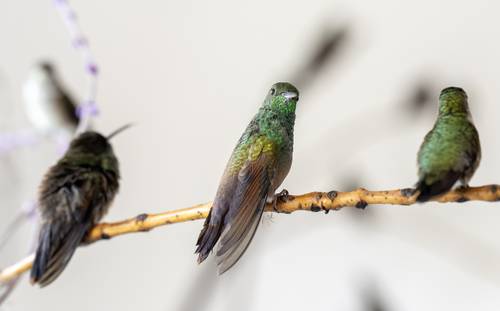The Jardines de Colibríes project seeks that the species survives in urban environments
With 80 flourers per second and the unique ability to fly back, the hummingbirds not only fascinate for their aerial skill, but are guardians of pollination and conservation of biodiversity
explained the ornithologist María del Coro Arizmendi Arriaga, promoter in Mexico of the successful Jardines de Colibríes project, whose purpose is to contribute to the conservation of the species in urban environments, where the human being has altered, partially or completely, the ecosystem.
In an interview with The day, In the context of the tenth anniversary of the installation of the first garden in the Faculty of Higher Studies (FES) Iztacala, the researcher stressed that these small birds, feeding on the nectar of flowers, transport pollen from one plant to another, favoring the perpetuation of key plant species for the ecological balance.
Eighty percent of the essential plants for humanity feeding depend on pollinators such as bees, butterflies, beetles, bats and hummingbirds.
Its presence also contributes to the diversification of the flora, which in turn benefits other organisms, such as insects and birds. Its presence encourages the creation of more resilient green spaces and increases biodiversity, fundamental elements to mitigate the effects of climate change
he added.
The hummingbirds face multiple challenges in their struggle to survive, from the loss of natural habitats due to urbanization and deforestation, to threats in cities such as badly designed cats and drinking fountains. Faced with this panorama, initiatives such as the gardens of hummingbirds have emerged as a promising solution.
Driven by Arizmendi Arriaga in Mexico City, these green spaces are designed to provide refuge and food through the use of native plants adapted to the weather and local rains.
The project is part of a joint work with the United States and Canada, through the North America pollinator protection campaign (NAppc). The first of these areas was installed in 2014, in the Faculty of Higher Studies Iztacala of the National Autonomous University of Mexico (UNAM). Since then, they have multiplied throughout the city, reaching more than 500 areas dedicated to conservation
This proposal represents a specific and effective response to preserve biodiversity in urban areas
the specialist explained.
In Iztacala, the presence of up to eight species of hummingbirds was documented, including the beryl crowned (Amazilia Beryllina) and the wide peak (Cynanthus latirostris).
Research Platform
In addition, these sites have served as platforms for scientific research, where about twenty students have explored topics such as the interaction of hummingbirds with plants, the effects of climate change and the presence of other pollinators
The loss of forests and jungles constitutes the greatest threat to hummingbirds, since it drastically reduces food sources and available shelters. In urban environments, poorly designed drinking fountains or crazy cat hunting also represent significant risks.
Each field won by man is a space that pollinators lose
Arizmendi warned.
In addition to the role played by the hummingbird gardens, the work of Catia Latotouf stands out, who transformed his home into Polanco into a hummingbird sanctuary, where he does a crucial work in the rehabilitation of these birds. In a separate interview, he said that he receives daily from four to five copies injured.
Since 2012, when he received the first of them, his voice was run and now they are looking for it from several Latin American countries. I am interested
.
On the work of Latotouf, Arizmendi stressed: She does a good work rehabilitating, healing and freeing them immediately. However, not everyone can do it, since many try to keep them in captivity, which is incompatible with the survival of this species
.
The scientist, who has 30 years doing studies on these populations, mentioned that the hummingbird gardens have established themselves as a replicable and low -cost alternative to protect birds and promote greater harmony with nature.
Mexico City did a great job; I hope the federal government can replicate it to promote greater harmony with nature and ensure that future generations continue to enjoy these fascinating beings.
